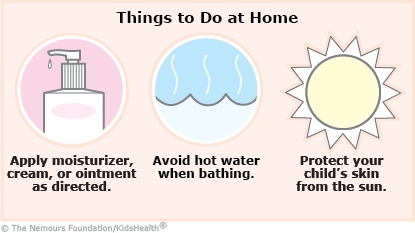Pityriasis Alba: How to Care for Your Child
Pityriasis (pit-ih-RYE-uh-sis) alba is a common, harmless skin condition that causes round or oval patches of pink or light-colored skin. It is most noticeable on darker skin or after skin gets tanned by the sun, making the pale patches stand out. Most kids grow out of it, but there are things you can do to help while the rash improves.


-
Apply moisturizer to the skin daily to relieve dryness.
-
If the health care provider has prescribed a cream or ointment, apply it as directed.
-
Avoid hot water when bathing and talk to your health care provider about how often your child should bathe.
-
Your child can protect their skin from the sun by:
-
Wearing sunscreen with an SPF of 30 or higher every day. Apply it 15–30 minutes before going outside, and again every 2 hours while your child is outdoors.
-
Staying in the shade when the sun is at its strongest (usually 10 a.m. to 4 p.m. in the summer).
-
Wearing a hat and clothes that shield the skin from the sun.
-
Reassure your child that the rash will go away in time and the skin color will go back to normal.


What causes pityriasis alba? Health care providers aren't sure what causes pityriasis alba. In some kids, it seems to be related to allergies and eczema (red, irritated, or dry skin). Protecting the skin from the sun, avoiding hot baths, and moisturizing the skin can lessen the appearance of the spots. Sometimes a prescription cream or ointment can help with dryness and itching.
Is pityriasis alba contagious? Pityriasis alba is not contagious (does not spread from person to person).
How long does pityriasis alba last? Usually, pityriasis alba clears up in a few months to a year. Sometimes it can take a few years. Following the health care provider's instructions can help reduce itching and may even help the rash heal more quickly.